Cát Bà: Paradise Island Reloaded
- Aaron Schorr
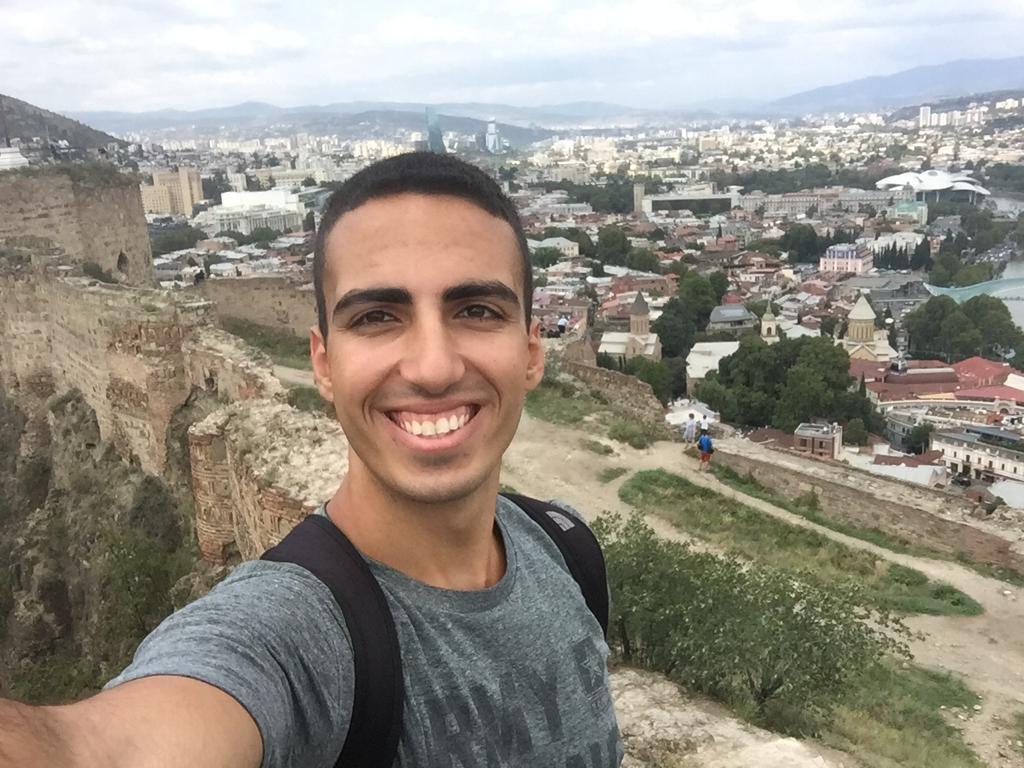
- Feb 12, 2020
- 12 min read
Updated: Feb 13, 2020
Ninh Bình, just across the highway from Tam Coc, is essentially the south-west corner of a triangle that extends north to Hanoi and east to the port city of Hai Phong. The interior of the triangle is a densely-populated urban agglomeration with a population of over 10 million, containing a massive port, the capital city, and most of Vietnam's industry. We had to essentially ride one leg of the triangle 160 kilometers to Cát Hải, a small island just south of Hai Phong.
Brutalist Bridges
Riding towards a major port through urban sprawl was about as enjoyable as you might imagine, with a never-ending stream of trucks filling the main roads. We reached the city of Thái Bình and left the miserable QL10 road, choosing to ride on smaller rural roads. The magical algorithm genie that powers Google Maps took us down some genuinely bizzare streches of road, including a narrow road completely clogged with high schoolers going home for lunch on scooters and several quintessential bike paths.
We reached Hai Phong and Google tried sending us on the Hanoi-Hai Phong motorway, despite having ticked the "avoid motorways" box, since motorcycles are not allowed on motorways in Vietnam. The resulting detour had us ride 30 kilometers through the teeming port city instead of 5 on a highway, but I didn't know if I was more irritated by Google for the navigation error or by the Vietnamese highway administration.
As we approached the port itself, the road became wider and wider, until I found myself on a five-lane road surrounded by industrial wasteland. The port is an urban planner's nightmare, miles upon miles of warehouses, factories, highways, and marshland hemmed by navigable channels.

Dredging ships and pipes were hard at work deepening the channels and reclaiming more land around them as we rode down the straightest road I've seen outside the Netherlands, a 13-kilometer-long concrete monstrosity taking us from the mainland to the island Cát Hải. It was so straight, in fact, that I managed to peel and eat a banana through my helmet without my right hand leaving the throttle. An enormous suspension bridge was visible in the distance, marking the even greater monstrosity that is the Hai Phong-Ha Long motorway.
Paradise Island Vol. II?
A mile east of Cát Hải was our destination, the island of Cát Bà in the north of the Gulf of Tonkin. There was supposed to be a ferry making the crossing, but a German couple near the ferry terminal said the ferry wasn't operating because of the Wuhan coronavirus outbreak. My heart sank; I really wanted to visit Cát Bà. Fortunately, the ticket office said the ferry was operating normally and we were actually joined by the same Germans for the crossing. The experience was a repeat of the ferry in Saigon, only with far fewer bikes and slower, the 1800 meter crossing taking around 20 minutes. At least they sold Oreos on board.
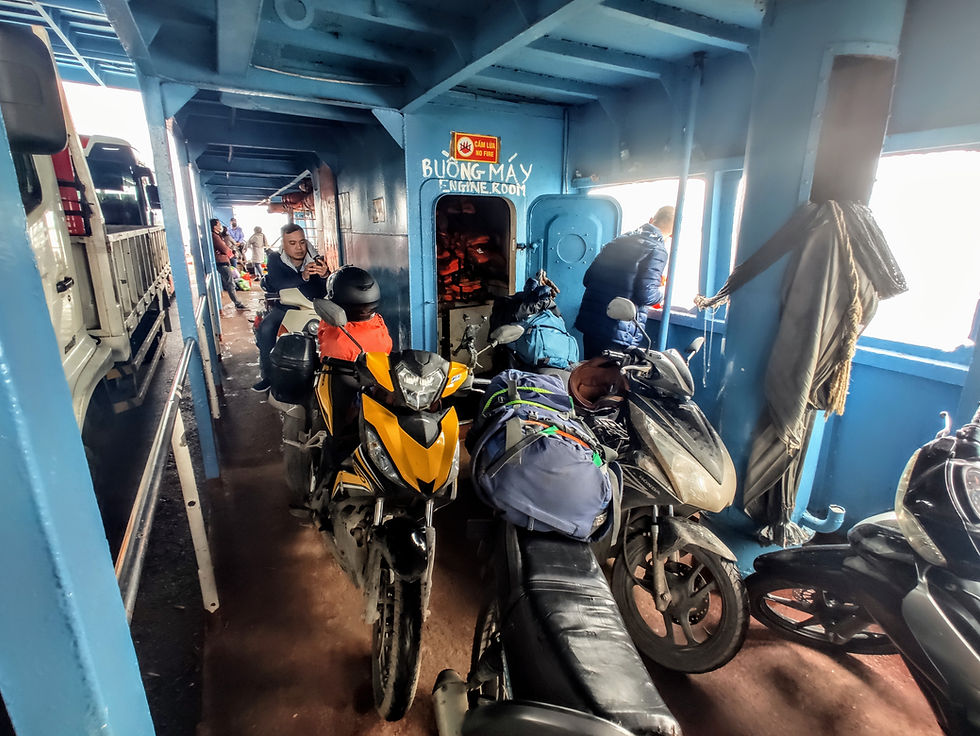
The road to the main town on the island was a truly wild ride, starting off as some of the best pavement I'd seen so far hugging the coastal cliffs, becoming a potholed gravel path, and then switching back and forth until arriving at the town. We reunited with Max, who had taken a morning bus, and rode to the center of the island to visit Hospital Cave. We thought it was just a cave you could explore, but it ended up being a museum about a wartime hospital that had literally been built inside a cave to escape the US bombing, operating room and all. The cave tapered off into a low passage where the fitness of recuperating soldiers was tested before they were redeployed by means of the Ho Chi Minh Trail. The whole thing was a memorial to the incredible hardiness of the Communist forces during the war, which to me seemed like a major factor in their ability to out-last the US in the incredibly long war of attrition.

Max said to follow him on the way back and led us off the main road near town. We discovered a semi-constructed neighborhood that had been abandoned before being inhabited. Vietnam is full of such ghost towns and I still can't figure out why or how this happens on such a large scale. There were wide paved streets complete with crosswalk signs, partially-built houses, and even a laughably large traffic circle, all just left to decay for some unknown reason. It felt like a map in a first-person-shooter video game and was thoroughly weird.

Our hostel had unlimited free beer at happy hour, which was a fantastic way to get to know other people quickly. We were all quite hungry, and Max said there was an Indian restaurant in the town with rave reviews. Normally I would avoid Indian food in a place like Vietnam, but I could have used a break from local food and my resistance was drowned out by the beer. It ended up being delicious, so delicious that we actually came back for dinner the next night again. We walked down the main street to an international bar, but it, like the rest of the town, was quite empty and we took a taxi back rather quickly.
Chinese-Free Territory
The coronavirus outbreak has dealt the Vietnamese tourism industry a crippling blow. The Chinese account for nearly a third of international visitors to Vietnam and they've all but disappeared over the last few weeks. After several diagnosed cases of the virus in Vietnamese cities, other nationalities seem to be avoiding the country as well. Combine that with the wintry low season in the north and you'll see why everywhere I've visited since Huế seems to get progressively emptier, with Cát Bà being the worst thus far.
The Vietnamese government has all but entered panic mode about the viral outbreak. Schools across the country have given off for two weeks until the situation stabilizes (following the long Tet holiday, the kids must be loving the virus). Surgical masks are being handed out by the box in the Cát Bà town center and at tourist accommodations, while the town's PA system blares information (unfortunately only in Vietnamese) about the virus at a deafening volume on repeat. Shockingly (to me at least), police officers have gone door to door between hotels on the island and literally expelled anyone with a Chinese passport; Chinese nationals are barred from the Cát Hải ferry as well, making the island chineserrein, a Chinese-free zone.
Karst, Kayaks and a Close Call
The reason I had been so keen to come to Cát Bà was to explore Hạ Long Bay, the northernmost part of the Gulf of Tonkin. Besides Cát Bà itself, the bay is full of hundreds of smaller limestone islands, with formations similar to those I had seen in Tam Coc. A cruise in the bay is one of the most expensive activities Vietnam has to offer, so backpackers generally head to Cát Bà, which offers access to the same waters at much lower prices. I did some price shopping the day we arrived and booked a full-day cruise for the three of us for the next day.
We got picked up at our hostel at 8 and drove to harbor on the island's eastern shore. I thought our cruise would be empty with the low numbers of tourists on the island, but it seemed all the tour providers joined forces to fill the boat together, meaning people were paying varying prices for the same thing. We set off and cruised through one of the floating villages the bay is known for. It's an incredible sight, an entire village built on the water and floating on empty plastic barrels and oil drums. The obvious livelihood is fishing, and fishing craft of different sizes and degrees of shoddiness can be seen sailing around.

Our first port of call was Monkey Island (Đảo Khỉ), a small but steep island inhabited only by - you guessed it - monkeys. A path led from the beach to the highest point on the island, taking us through some dense forest and onto jagged rock formations. Unsurprisingly, there were no railings or indeed anything else to prevent unfortunate tourists from plunging down cliffs and onto sharp rocks below.

In a lapse of attention, I lost my footing while climbing one of the rocks and desperately tried to right myself unsuccessfully. I fell backwards onto the rock below me, my head narrowly missing some sharp spikes. I was shaken up but fine, with nothing worse than some cuts on my hand, shoulder, and leg. It seemed one of the spikes had torn the skin off the exhaust burn on my leg, so I was thankful to be wearing a bathing suit which wasn't clinging to it.
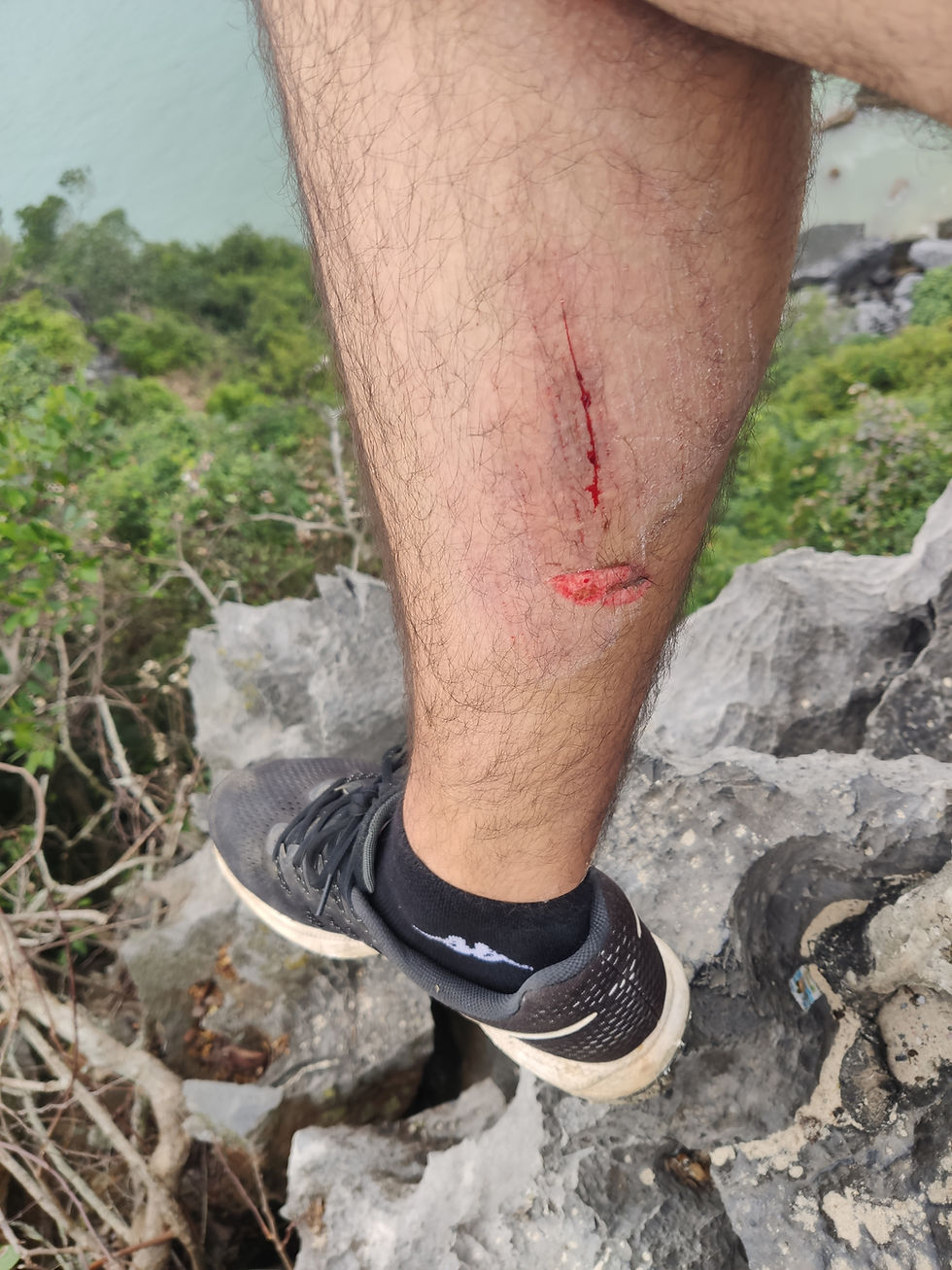
The view was too good to miss out on, however, with dozens of small islands lining the foggy horizon and a choppy grey see below, so I stayed for a photo shoot and then carefully made my way back down. Back on the beach, I asked our guide, a local named Trí, for some first aid equipment to patch up my injuries. He returned with iodine, bandages, and some Vietnamese cigarettes, earning him 10 points for effort.

The tide had come out and the water was too shallow for the ship to dock on the beach again, so we waded into the water and were ferried to the ship on a small boat with a captain straight out of a Vietnam War movie, with a surgical mask bringing me back to the present.


We sailed to the border between Lan Ha Bay and Hạ Long Bay, the water around us dotted with small islands and limestone pillars, a timeless and alien landscape which felt untouched by man.

After lunch on board, we sailed into a protected cove surrounded by larger islands. A floating kayaking station had been built in the cove; Mihal and I got in one and set off deeper into the cove. We rowed through a cave and found ourselves in beautiful turquoise water. Surrounded by green islands, the only sound was water dripping off our oars. I felt very small, exploring an empty landscape that had formed over millions of years. It was far from the first time that had been true, but the beauty and tranquility of the place made me feel it much stronger than in other places.
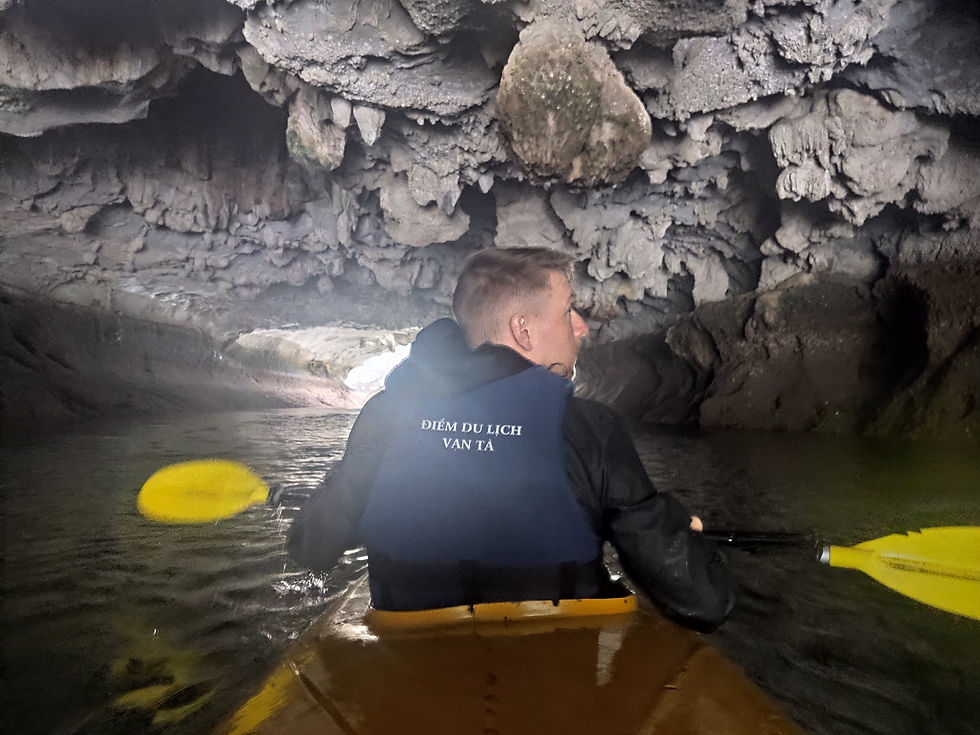
The spell was broken when we rowed through another cave and found another kayak that had run around in the shallow water. After helping them get free, we decided it would be a good place for a bathroom break. Big mistake. The seabed and shore were extremely sharp surfaces and the 20 meter walk from the kayak felt like walking on broken glass. I later discovered a small piece of rock that had actually embedded itself in my foot, refusing to come out until the next day. We then ran aground ourselves and had to get out to free our kayak; Mihal nearly tipped me over in the process, soaking my windbreaker with salt water. All in all, not bad for a 90 minute kayaking trip.

The ship took us back into the bay and Trí said we could swim. I thought the water was a touch cold for swimming but Max talked me into doing it anyhow. In return, I made him dive off the upper deck with me. Falling 15 feet into a cold ocean is one way to get your pulse up and the Asians on the ship were cheering us on, as 100% of the people who had decided to swim were white.
Toweling off, I took a moment to reflect on the day. I had a gash in my hand, a cut on my shoulder, a skinned burn and some scratches on my leg, a piece of rock in my foot, I was cold and wet, but I couldn't wipe the smile off my face. It had been one of those amazing days where even all the injuries and physical discomfort couldn't offset the sheer joy of discovering such a beautiful part of the world. To make it better, the entire tour had set me back only $13, a far cry from the sums charged for the classic Hạ Long Bay tours.
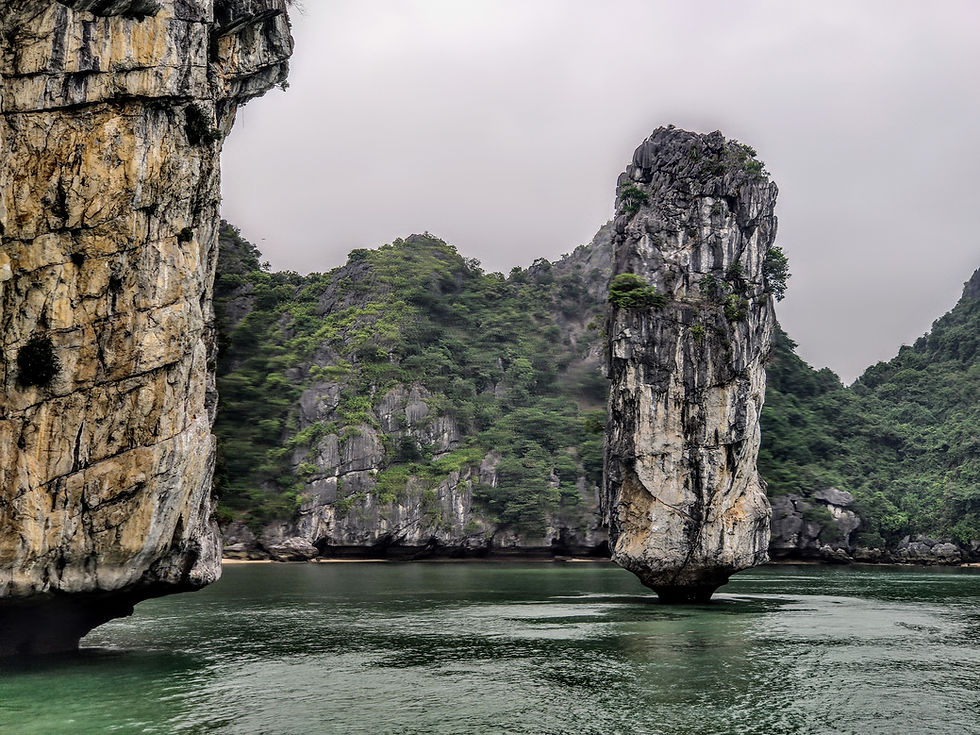
All Aboard the Magic School Bus
We decided to spice up our hour of free beer and played a drinking version of Jenga in which we'd have to finish our drinks every time the tower came down, which naturally created a positive feedback loop as our Jenga skills deteriorated. Max went to bed but we were joined by an Austrian named Sebastian, a Dutchman named Jos, and two Quebecoise girls named Noémie and Cath. We played cards for a while and were debating going into town when the receptionist showed up and said there was a bus outside waiting to take anyone who wanted to a bar called Oasis.We collectively shrugged and got on the "bus", which turned out to be an oversized bright yellow golf cart, with some other guests.
Oasis was the Vietnamese backpacker scene on steroids, something I hadn't experienced since Hoi An. There was more free beer, beer pong, laughing gas balloons, carts selling pancakes and bánh mì, and a 2013 playlist (most songs newer than 2015 don't seem to have made it to Vietnam and the playlists are pretty darn similar throughout the country). An American named Christian and a Dutch group seemed to be in a competition who could get more drunk; I needed some air.
I sat down outside with the Canadians and some strangers. Jos came and started talking to one of the strangers; it quickly became apparent he was a drug dealer. As it turned out, he had moved to the island from a rather distant foreign country (I'm going to keep the details as ambiguous as possible) and had been supplying the tourists and residents with drugs for over a year now. "It's a good life," he said, as he gave the bánh mì stand owner some pot to smoke in something that looked like a cross between a bong and a pipe and rolled himself a joint. The whole of Cát Bà feels a little lawless, like the rule of the Vietnamese government doesn't extend past the mainland, and our new friend seemed to be enjoying it.
Rumors were circulating about a bus back to the hostel at 1 am, the bar's closing time. I was skeptical, but like clockwork it appeared on time, more punctual than anything else I had seen in Vietnam. We piled back on board what I had taken to calling the Magic School Bus, Mihal sitting on the passenger-side dashboard for lack of a better seat.

The World's Worst Pond
Mihal sadly left the next morning to catch a flight back home. It had been a wild ride (often literally) and I had really enjoyed the company. The rest of the riding would be in really rural areas and I hoped it wouldn't get too lonely.
Max had suggested we do some hiking and Jos and the Quebecoise decided to join us. The girls rented a motorbike but said they were terrible riders, so Max rid theirs with Cath as his passenger and Noémie rode behind me. You could tell they were new to Southeast Asia by the way they rode as pillion passengers, holding on to the driver's waist. It was fine as long as the road was smooth, but as soon as we hit a pothole, which is a pretty common occurrence on Cát Bà, I would get pinched in the ribs, often accompanied by a yelp.

Some online research suggested we visit the Trung Trang Cave, located roughly in the center of the island. It was a really beautiful cave, with impressive stalactites and vivid colors of rock, and surprisingly warm inside, but we were back outside within half an hour.

We headed further down the road and into the national park, where there were some hiking paths. There was a map with 8 different trails but signs to only one of them, and the park employees couldn't speak enough English for us to make ourselves understood. Max found another trail online and we decided to follow it instead. After a "shorcut" through the forest, we found ourselves walking down a road that had been partially reclaimed by nature. The trail was supposed to end at a pond, but when we got there an hour and a half later it was a dead end surrounded by more forest and very little else, least of which other hikers.

My foot was hurting rather badly by now due to the rock that was stuck in it from the previous day so we turned back, briefly catching a view of our surroundings in a gap in the trees on the way back. The brush on Cát Bà was much thicker than other places I had visited, which had played to our disadvantage this time. I suspected the reason was that the island had emerged relatively unscathed from the war, its limited military importance sparing it the wrath of US bombs, napalm and defoliants that had left such a mark in the Central Highlands and near the DMZ.

Find the Fort
Max got on a bus to Phong Nha, I finally got the rock out of my foot, and it was time for dinner. Jos said he had found a weird place to eat dinner, so with Sebastian on the back of my bike we went to look for it. We rode back to the wharf we had used for the boat tour, where there was supposed to be an old fort with a restaurant in it. I had searched for the fort the previous day, interested by some WWII anti-aircraft guns that were supposed to be there, but hadn't found it. A café owner who spoke excellent English explained to us that the fort was closed to visitors after the military and local authorities had gotten into an ownership fight, which explained why we couldn't find it. After trying some fish restaurants which were all closed (presumably due to the viral outbreak), we ended up in a place that served us all different dishes from what we had ordered, but at least they managed to get our beer orders right. With long days of riding ahead of us, Jos and I had an early night; Sebastian went back to Oasis to meet some Canadian vlogger who had been on the cruise with him and had provided us with prime entertainment after watching his videos at the hostel (side note: the vlogger's name is Borders on Budgets and he is unintentionally hilarious; watch his videos from Cambodia if you have 10 minutes and thank me later).






Comments